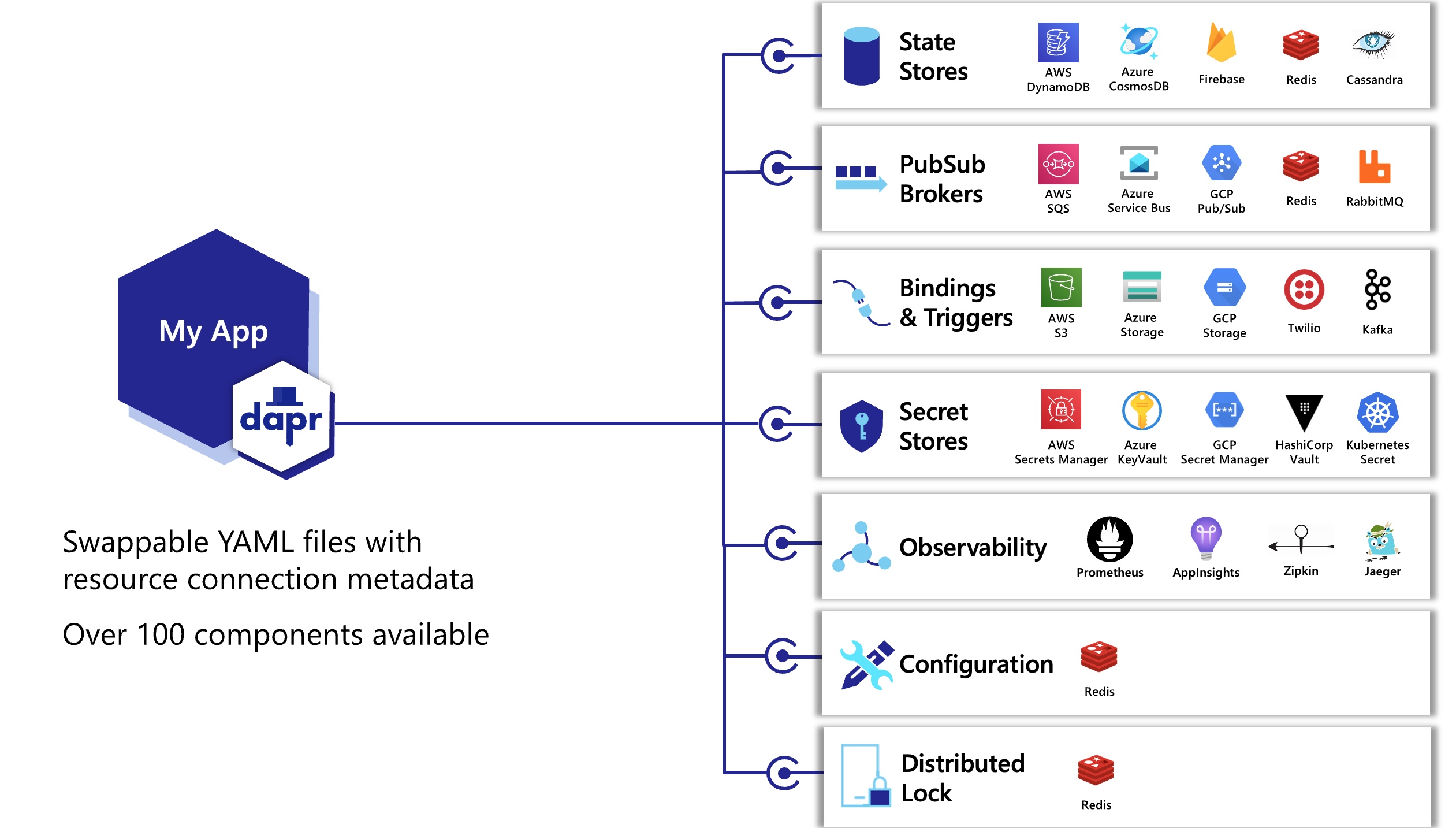The documentation you are viewing is for Dapr v1.9 which is an older version of Dapr. For up-to-date documentation, see the latest version.
Components
Dapr uses a modular design where functionality is delivered as a component. Each component has an interface definition. All of the components are interchangable so that you can swap out one component with the same interface for another.
You can contribute implementations and extend Dapr’s component interfaces capabilities via:
A building block can use any combination of components. For example, the actors and the state management building blocks both use state components.
As another example, the pub/sub building block uses pub/sub components.
You can get a list of current components available in the hosting environment using the dapr components CLI command.
Component specification
Each component has a specification (or spec) that it conforms to. Components are configured at design-time with a YAML file which is stored in either:
- A
components/localfolder within your solution, or - Globally in the
.daprfolder created when invokingdapr init.
These YAML files adhere to the generic Dapr component schema, but each is specific to the component specification.
It is important to understand that the component spec values, particularly the spec metadata, can change between components of the same component type, for example between different state stores, and that some design-time spec values can be overridden at runtime when making requests to a component’s API. As a result, it is strongly recommended to review a component’s specs, paying particular attention to the sample payloads for requests to set the metadata used to interact with the component.
The diagram below shows some examples of the components for each component type

Built-in and pluggable components
Dapr has built-in components that are included as part of the runtime. These are public components that are developed and donated by the community and are available to use in every release.
Dapr also allows for users to create their own private components called pluggable components. These are components that are self-hosted (process or container), do not need to be written in Go, exist outside the Dapr runtime, and are able to “plug” into Dapr to utilize the building block APIs.
Where possible, donating built-in components to the Dapr project and community is encouraged.
However, pluggable components are ideal for scenarios where you want to create your own private components that are not included into the Dapr project. For example:
- Your component may be specific to your company or pose IP concerns, so it cannot be included in the Dapr component repo.
- You want decouple your component updates from the Dapr release cycle.
For more information read Pluggable components overview
Available component types
The following are the component types provided by Dapr:
State stores
State store components are data stores (databases, files, memory) that store key-value pairs as part of the state management building block.
Name resolution
Name resolution components are used with the service invocation building block to integrate with the hosting environment and provide service-to-service discovery. For example, the Kubernetes name resolution component integrates with the Kubernetes DNS service, self-hosted uses mDNS and clusters of VMs can use the Consul name resolution component.
Pub/sub brokers
Pub/sub broker components are message brokers that can pass messages to/from services as part of the publish & subscribe building block.
Bindings
External resources can connect to Dapr in order to trigger a method on an application or be called from an application as part of the bindings building block.
Secret stores
A secret is any piece of private information that you want to guard against unwanted access. Secrets stores are used to store secrets that can be retrieved and used in applications.
Configuration stores
Configuration stores are used to save application data, which can then be read by application instances on startup or notified of when changes occur. This allows for dynamic configuration.
Locks
Lock components are used as a distributed lock to provide mutually exclusive access to a resource such as a queue or database.
Middleware
Dapr allows custom middleware to be plugged into the HTTP request processing pipeline. Middleware can perform additional actions on an HTTP request (such as authentication, encryption, and message transformation) before the request is routed to the user code, or the response is returned to the client. The middleware components are used with the service invocation building block.
Note
Since pluggable components are not required to be written in Go, they follow a different implementation process than built-in Dapr components. For more information on developing built-in components, read developing new components.Feedback
Was this page helpful?
Glad to hear it! Please tell us how we can improve.
Sorry to hear that. Please tell us how we can improve.